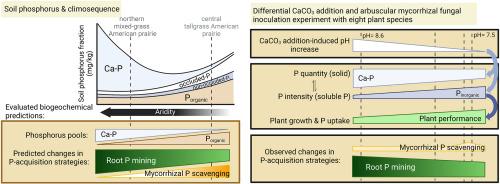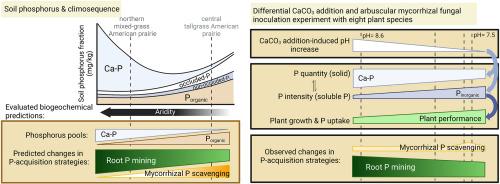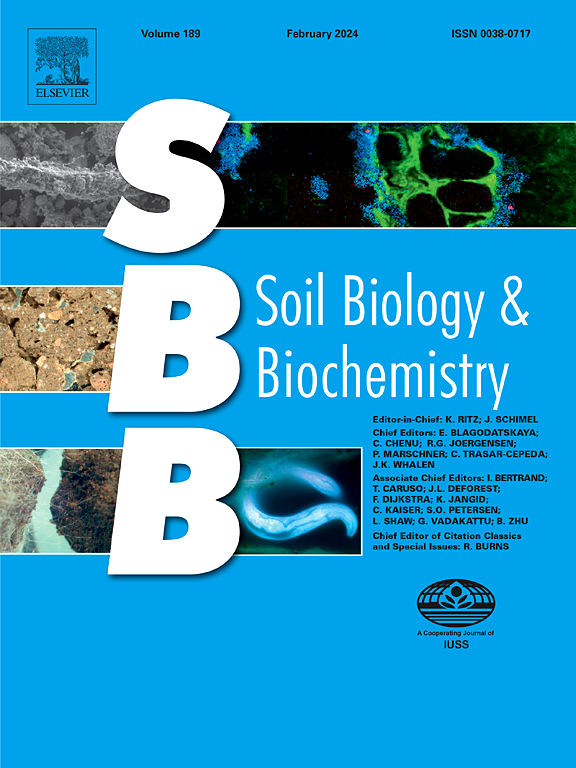Experimental evidence that poor soil phosphorus (P) solubility typical of drylands due to calcium co-precipitation favors autonomous plant P acquisition over collaboration with mycorrhizal fungi
IF 9.8
1区 农林科学
Q1 SOIL SCIENCE
引用次数: 0
Abstract
Calcareous dryland soils are rich in precipitated phosphate and represent >30% of Earth's land, yet the relative importance of phosphorus-acquisition strategies (PAS) among plant species in these systems is not well known. No experiment has investigated potential interactions between varying amounts of added calcium carbonate (CaCO3) and arbuscular mycorrhizal fungi (AMF) on plant performance and PAS which could test for potential mechanisms without the limitations of in-situ comparisons along natural gradients. To fill this knowledge gap, we conducted an experiment with CaCO3 addition, AMF inoculation, and three invasive and five native grassland plants. We expected an increase in soil [CaCO3] of an alkaline subsoil to 1) reduce soil-available phosphorus (P), 2) reduce plant biomass and P uptake, and 3) shift PAS toward increased root mining as Ca-bound P increases. The largest CaCO3 addition reduced available P by as much as 57%. On average, the largest addition of CaCO3 reduced total biomass of plants by 19% and plant uptake of P by 15%. The PAS seemed to have changed, and CaCO3 additions tended to increase an indicator of root exudation (shoot [Mn]) to mobilize Ca-bound P, suggesting plasticity for some inducible root mining, especially Artemisia frigida and Poa secunda. However, CaCO3 and plant species interacted to affect shoot [Mn]. The invasive grass Bromus tectorum was superior at acquiring P (> P uptake, > shoot [Mn]) and thus tolerating low soluble P conditions. Rarely did AMF and CaCO3 interact to affect plant biomass. When they did, mycorrhizal responsiveness did not increase where P was less available, suggesting AMF become less beneficial upon P and Ca coprecipitation. In dryland soils with less soluble P, plants are thus likely to rely more on root mining PAS than mycorrhizal scavenging, except for the invasive forb Euphorbia esula that always benefitted from AMF inoculation.


实验证明,由于钙共沉淀作用,干旱地区典型的土壤磷(P)溶解度低,这有利于植物自主获取磷,而不是与菌根真菌合作获取磷
钙质旱地土壤含有丰富的沉淀磷酸盐,占地球陆地面积的 30%,但这些系统中植物物种的磷获取策略(PAS)的相对重要性却鲜为人知。目前还没有任何实验研究过不同添加量的碳酸钙(CaCO3)和丛枝菌根真菌(AMF)对植物表现和磷获取策略的潜在相互作用。为了填补这一知识空白,我们进行了一项实验,加入 CaCO3、接种 AMF 以及 3 种入侵植物和 5 种本地草地植物。我们预计,碱性底土中土壤[CaCO3]的增加会:1)减少土壤中可利用的磷(P);2)减少植物的生物量和 P 吸收量;3)随着 Ca 结合的 P 的增加,PAS 向增加根系挖掘的方向转变。CaCO3 的最大添加量使可用磷减少了 57%。平均而言,CaCO3 的最大添加量使植物的总生物量减少了 19%,植物对 P 的吸收量减少了 15%。PAS 似乎发生了变化,CaCO3 的添加往往会增加根系渗出的指标(芽[Mn]),以调动与 Ca 结合的钾,这表明一些诱导性根系开采具有可塑性,特别是蒿属植物和 Poa secunda。然而,CaCO3 和植物物种相互作用影响嫩枝[Mn]。入侵性禾本科植物 Bromus tectorum 在获取钾(钾吸收,嫩枝[Mn])方面更胜一筹,因此可以耐受低可溶性钾条件。AMF 和 CaCO3 很少相互作用影响植物的生物量。当它们发生作用时,菌根的反应能力并没有在可获得的钾较少的地方增加,这表明在钾和钙共沉淀时,AMF 的益处较少。因此,在可溶性钙较少的旱地土壤中,植物可能会更多地依赖于根采矿PAS,而不是菌根的清除作用。
本文章由计算机程序翻译,如有差异,请以英文原文为准。
求助全文
约1分钟内获得全文
求助全文
来源期刊

Soil Biology & Biochemistry
农林科学-土壤科学
CiteScore
16.90
自引率
9.30%
发文量
312
审稿时长
49 days
期刊介绍:
Soil Biology & Biochemistry publishes original research articles of international significance focusing on biological processes in soil and their applications to soil and environmental quality. Major topics include the ecology and biochemical processes of soil organisms, their effects on the environment, and interactions with plants. The journal also welcomes state-of-the-art reviews and discussions on contemporary research in soil biology and biochemistry.
 求助内容:
求助内容: 应助结果提醒方式:
应助结果提醒方式:


